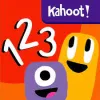Take a look inside 6 images
Kahoot! Numbers by DragonBox
Pros: Hundreds of puzzles ensure that kids can't zip through activities in a heartbeat.
Cons: Other than height, not all Nooms have a quick visual clue as to what number they represent.
Bottom Line: Though there are a few kinks, kids experience fun gameplay while internalizing fundamental number concepts.
The Kahoot! Numbers by Dragonbox website offers a learning guide that explains the pedagogy behind each aspect of the game and suggests some ways for teachers to support kids' learning through the app. It's worth taking a quick look to orient yourself and understand more about what the games offer. Teachers can create up to four accounts on each device. Though it's ideal that kids would play under their own account, it's not vital.
As learning is meant to be seamlessly embedded within the experience of exploration and gameplay, let kids freely explore the games. Stand by, however, to provide help and support in kids making the leap toward explicit understanding of what they're doing. Ask questions such as, how many different ways can you make the number 10? How can you make numbers bigger and smaller? And because the Nooms mimic real-life math manipulatives, try introducing concepts with tactile activities and then moving to the app for reinforcement.
Kahoot! Numbers by Dragonbox introduces kids to basic number concepts through games, puzzles, challenges, and free play. "Nooms" represent each number from 1 to 10. Kids can stack Nooms, have them "eat" each other and turn into different Nooms (for example, three eats five and becomes eight), or slice them into smaller Nooms. In the Sandbox, kids freely experiment with the Nooms against a number line. In Ladder, kids build a Noom to reach a star on a number line, which gets more challenging as they want to avoid or pass through certain points along the way. In Puzzles, kids create pictures using the Nooms in certain ways. And in Run, kids must use mental calculations to quickly identify and estimate numbers as they play an endless runner game. All activities earn coins that kids can use to "buy" more levels.
Silly Nooms get kids interacting with and manipulating numbers in this set of creative games. Kahoot! Numbers by Dragonbox joins the other games in the DragonBox series as a stellar example of seamlessly incorporating important mathematical concepts into a fun game environment. The four play areas offer a good combination of free exploration and goal-oriented challenges.
The games purposefully do not have any explicit help, but sometimes it feels like a little explanation would actually help avoid confusion. For instance, other than their height, clues to which number each of the Nooms represents aren't always clear. Teachers will likely need to explain, for example, why the number seven Noom has two eyes rather than seven. Without a clear understanding, levels in which kids must construct Nooms to match the target one identified only by its face can be confusing. And the support that's included is inconsistent: For example, when kids add a number two with a number three Noom, sometimes it says, "two plus three, five," and sometimes it doesn't. Teachers can sign up for an account to get additional resources and supposedly see reports on what their students are doing, but that function didn't seem to be working properly at the time of this review. Despite these issues, there's definitely great potential here.















